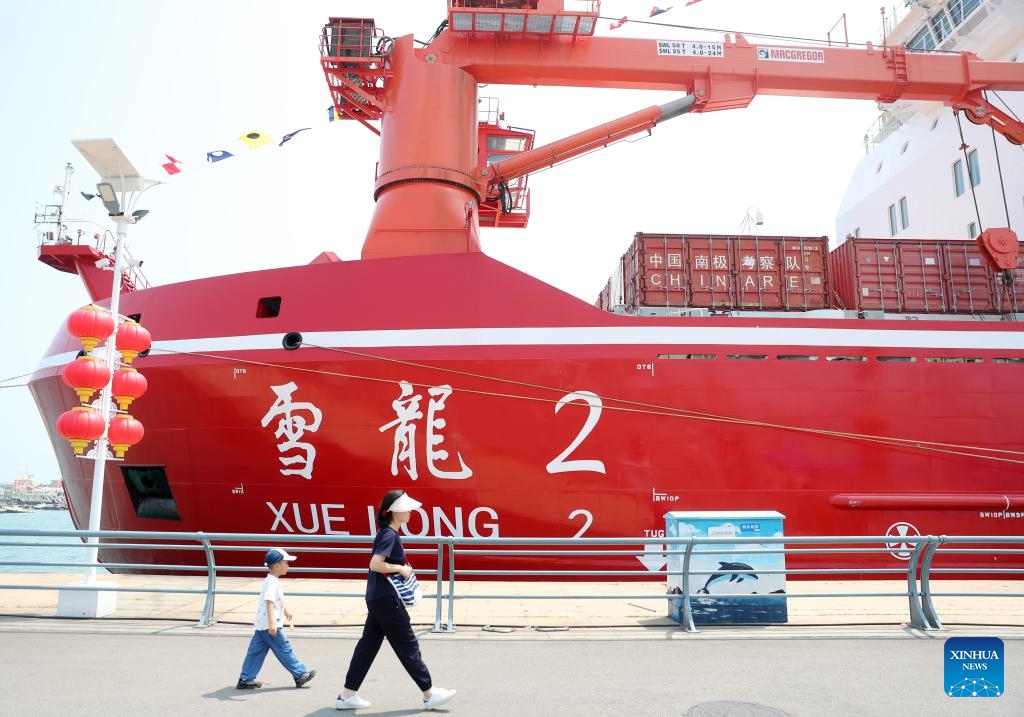
This photo taken on July 3, 2024 shows China's icebreaker Xuelong 2 berthing at the pier of Qingdao Olympic Sailing Center in Qingdao, east China's Shandong Province. China's icebreaker Xuelong 2 and icebreaker research vessel Jidi were open to public here on Wednesday. This is also the first time for Jidi, China's independently designed and built icebreaker research vessel, to allow for public visit since its official delivery on June 24 this year. (Photo: Xinhua)
The research and development of China's heavy icebreaker is progressing smoothly with construction expected to begin next year, Wu Gang, chief designer of Xuelong 2, China's first domestically built polar research icebreaker, told the Global Times.
China's future generation of icebreakers will make significant breakthroughs in both spatial and temporal domains. This means that once the heavy icebreaker is successfully developed, China will have the ability to operate year-round in polar environments for in-depth scientific research missions and obtain the capabilities of full-area and all-time entry, according to Wu.
Icebreakers are classified into three levels based on their icebreaking capability, heavy icebreakers can handle ice up to 2 meters thick, medium icebreakers can break ice between 1 and 1.5 meters, and light icebreakers can manage ice less than 1 meter thick.
China has developed the capability to design and construct light and medium icebreakers. However, there is still a significant shortage of icebreaking research vessels, particularly heavy-duty icebreakers, Wu noted.
On June 24, China's latest research vessel Jidi, meaning polar region, was officially delivered in Guangzhou city of South China's Guangdong Province and was reportedly set to kick off its first scientific research missions in the second half of this year.
Currently, most operational polar icebreakers worldwide are operated by Russia, the US, Canada, Finland, Sweden, and Denmark. Among them, Russia is the only country in the world with nuclear-powered icebreakers.
In the short term, there is still a significant gap between China and traditional leading countries in icebreaker building, according to Wu. He highlighted the challenges in advancing crucial technologies for the development of heavy-duty icebreakers, like podded propulsion systems, precise communication navigation system and positioning system. "This pressure pushes Chinese researchers to continue to develop and innovate independently," he said.
China and Russia released a joint communique on Wednesday after the 29th regular meeting between Chinese and Russian heads of government.
In the communique, the two sides said that efforts will be made to expand mutually beneficial cooperation in the Arctic region, and strengthen cooperation in shipping development, navigation safety, polar ship technology and construction. Both countries will encourage their enterprises to actively engage in Arctic shipping routes cooperation based on market principles and pay special attention to Arctic environmental conservation.
China's progress in icebreakers has caught the attention of several leading icebreaker countries. US, Canadian, and Finnish governments recently announced the Icebreaker Collaboration Effort (ICE) Pact, an initiative to produce 70 to 90 icebreakers for their allies over the next decade, Reuters reported. The move was taken as a response to growing competition with China and Russia in the Arctic regions, Reuters said citing a US official whose name was ungiven.
Chinese experts reiterated China's icebreakers are mainly used for scientific research in the Arctic region and to prepare for the opening and transportation of the future Arctic route.




